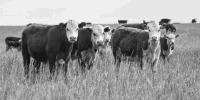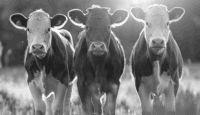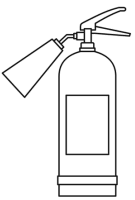

To send a message to an author, click on the author's name at the end of the article.
This Month in Ag Connection | Ag Connection - Other Issues Online

Grazing management is the process of planning, administering, and monitoring the use of forage resources by livestock. This includes managing grazing intensity, timing, and rotation to ensure sustainable forage production, improve land health, and support livestock productivity. Producers should start with setting goals for the grazing season, examples include preventing overgrazing, promoting plant recovery, controlling weed growth, improving pastures and plant resistance. Even with good grazing management in place a producer may not be able to control the effects from less-than-ideal environmental conditions such as drought which reduces forage production.
Stockpiling tall fescue is a traditional tool that has been used to extend the grazing season. Pastures should be grazed or clipped before August, then nitrogen should be applied to increase forage production. Grazing is typically deferred until the middle of November. After November 15, forage production significantly declines. Stockpiled tall fescue generally has 12.5% crude protein (CP) and 59.5% neutral detergent fiber (NDF), compared to tall fescue hay which has 7.5% CP and 65.3% NDF.
Cool season annuals are another option producers should consider. Forage oats can be seeded in February-March or July-August at a rate of 80-100 lbs. per acre. Annual ryegrass can be seeded March-April or August-October at a rate of 20-30 lbs. per acre. Small grains such as cereal rye, wheat, triticale, and barley can be seeded August-October at a rate of 90-120 lbs. per acre. Brassicas such as turnips, radishes, and kale can be seeded February-March or July-August at a rate of 2-5 lbs. per acre. Brassicas should be less than 50% of the diet, grazing deferred 60-120 days after planting (14 inches), and strip or rotationally grazed leaving 6 to 8 inches behind.
If pasture forage production is not adequate, and hay being fed is below 55% total digestible nutrients (TDN) or 7% CP it will need to be supplemented. This is where distiller grains shine, providing a source of both protein and energy. To correct energy deficiency, 5-6 lbs. of energy supplement will be needed. Feeding straw, corn stalks, or hulls as forage source, energy supplement can be doubled, if needed. During a period of short forage supply, consider culling open cows or heifers, animals with feet and udder issues, and animals that do not maintain body condition. Destocking options include weaning calves early and selling replacement heifers.
Even with good grazing management rotations will vary and cattle may spend less time in rotation compared to periods with surplus forage supply. In any rotation it is recommended to leave a stubble height of four to 5 inches to promote regrowth. Without good grazing management, there is no immediate or cheap solution to short forage supply and limited hay supply. Producers should focus on grazing management to combat issues from short forage supply to extend the grazing season.
Source: Chrisee Brandl, Field Specialist in Livestock
This Month in Ag Connection | Ag Connection - Other Issues Online

Homeowners may need the services of a tree care professional occasionally. Here are some key tips for hiring a qualified, trustworthy tree care professional:
For more information contact the local MU Extension Office.
Source: Joni Harper, Field Specialist in Natural Resources
This Month in Ag Connection | Ag Connection - Other Issues Online

The Northeast Missouri Show-Me-Select Replacement heifer program held a fall calving heifer sale where 182 heifers averaged $3,926. The sale was held on Saturday, June 7th at F & T Livestock Auction in Palmyra.
The 12 producers were enrolled in the University of Missouri Extension's educational heifer management program. The heifers were bred to sires with both calving-ease and growth genetics. The top selling lots, consigned by both Mosby Cattle Co. and Twin Hill Stock Farm brought $4,400.
The highest consignor average was $4,113 on eight head from Mosby Cattle Co, Silex. Other high averaging consignors were E&A Belgian and Cattle Farms, Curryville, $4,100 on eight head, and Schieffer Farm, Troy, $4,067 on three head. Twenty-six buyers purchased over $714,000 worth of bred heifers: exchanging hands in less than one hour.
The Show-Me-Select heifer development program takes nearly a year to complete. Pre-breeding exams are completed on heifers usually four to eight weeks before being bred. These exams include a pelvic measurement, reproductive tract score, and weight record. Heifers may be bred artificially or be exposed to natural service, however; the service sires must meet specific calving ease EPD requirements based on breed. This year 100 head, or 55 percent, of the heifers in the sale were synchronized and bred AI.
All heifers must be pregnancy tested within 90 days of breeding by a veterinarian to determine expected calving date. The use of ultrasound has helped many of the veterinarians improve accuracies on calving dates. During the development period the heifers undergo an extensive health program and are vaccinated at weaning, pre-breeding, and pregnancy examination as well as treated several times for internal and external parasites. Heifers are also screened for blemishes, condition, muscling and structural soundness by MU Extension livestock specialists and Missouri Department of Agriculture graders. Purchasers provide feedback to the consignor by completing calving surveys which provide important information to guide improvements in future years.
This is the 29th year for the Show-Me-Select heifer sale in Palmyra, over 52,000 heifers have been through the program, and 9,122 head have been sold. If interested contact the local MU Extension Livestock Specialist.
Source: Daniel Mallory, Field Specialist in Livestock
This Month in Ag Connection | Ag Connection - Other Issues Online

Selecting the correct fire extinguisher is important to extinguish a fire in the field or on a piece of equipment. It is recommended that one 10-pound ABC extinguisher be kept inside the tractor or combine, and one 20-pound ABC extinguisher be mounted outside the tractor or combine on the opposite side of the door, which can be reached from the ground. At a minimum, keep one 10-pound, fully charged ABC fire extinguisher on each piece of equipment.
The ABC designation refers to the class of the fire. Class A fires are combustibles such as wood, cloth, paper or hay. Water is the best way to extinguish these fires. Pressurized water extinguishers can be carried on equipment where hay or crop residue may ignite. Class B fires involve things like oils, grease, paint or other flammable liquids. Oxygen deprivation is the best way to extinguish Class B fires. Class C fires are electrical fires. Carbon dioxide is the best way to put out a Class C fire. Never use water to put out an electrical fire due to the risk of electrical shock. An ABC fire extinguisher is effective at putting out all three types of fires. The U.S Fire Administration recommends selecting a fire extinguisher that has a label to ensure it has been certified by a nationally recognized testing laboratory.
Visually inspect extinguishers monthly for cracks in the hose and that the gauge indicates the extinguisher is fully charged. Invert the extinguisher several times and shake vigorously to ensure the powder inside has not become compacted from vibrations of the machine. Have a professional inspect fire extinguishers annually.
If a fire occurs, call 9-1-1 before attempting to put out the fire. Implement the P.A.S.S. strategy - Pull, Aim, Squeeze, Sweep. Pull the pin with the nozzle pointing away from the user to release the locking mechanism. Aim at the base of the fire. Squeeze the trigger slowly and evenly to release the contents. Sweep from side to side to extinguish the fire. A shovel to cover a fire with soil and a leaf blower can also be helpful tools in the event of a fire.
More information can be found at https://ohioline.osu.edu/factsheet/aex-591111.
Source: Valerie Tate, Field Specialist in Agronomy
This Month in Ag Connection | Ag Connection - Other Issues Online
Trivia Questions:
Trivia Answers:
This Month in Ag Connection | Ag Connection - Other Issues Online
Warren County - Aug. 20-22
Warrenton, MO
For details call 636-456-3434 ext. 3
Morgan County - Sept. 4-6
Versailles, MO
For details call 573-378-5822 ext. 3
Linn County - Sept. 30 - Oct. 2
Linneus, MO
For details call 660-895-5123
Or email tatev@missouri.edu
This Month in Ag Connection | Ag Connection - Other Issues Online
Pearls of Production (education designed for women in livestock production) has upcoming events Sept,. 23, Oct. 28 and Nov. 8.
More details https://tinyurl.com/MU-Pearl25.
This Month in Ag Connection | Ag Connection - Other Issues Online
Research, Extension and Education Centers Field Days
Aug. 6 - Fisher Delta, Portageville, MO
Sept. 4 - Tomato Festival, Jefferson Farm & Garden, Columbia, MO
Sept. 18 - Southwest, Mount Vernon, MO
Oct. 4 - South Farm, Columbia, MO
Oct. 18 - Chestnut Roast, Horticulture and Agroforestry Farm, New Franklin, MO
This Month in Ag Connection | Ag Connection - Other Issues Online

Publishing Information
Ag Connection is published monthly for Northeast and Central areas of Missouri producers and is supported by the University of Missouri Extension, the Missouri Agricultural Experiment Station, and the MU College of Agriculture, Food and Natural Resources. Managing Editor: Mary Sobba.